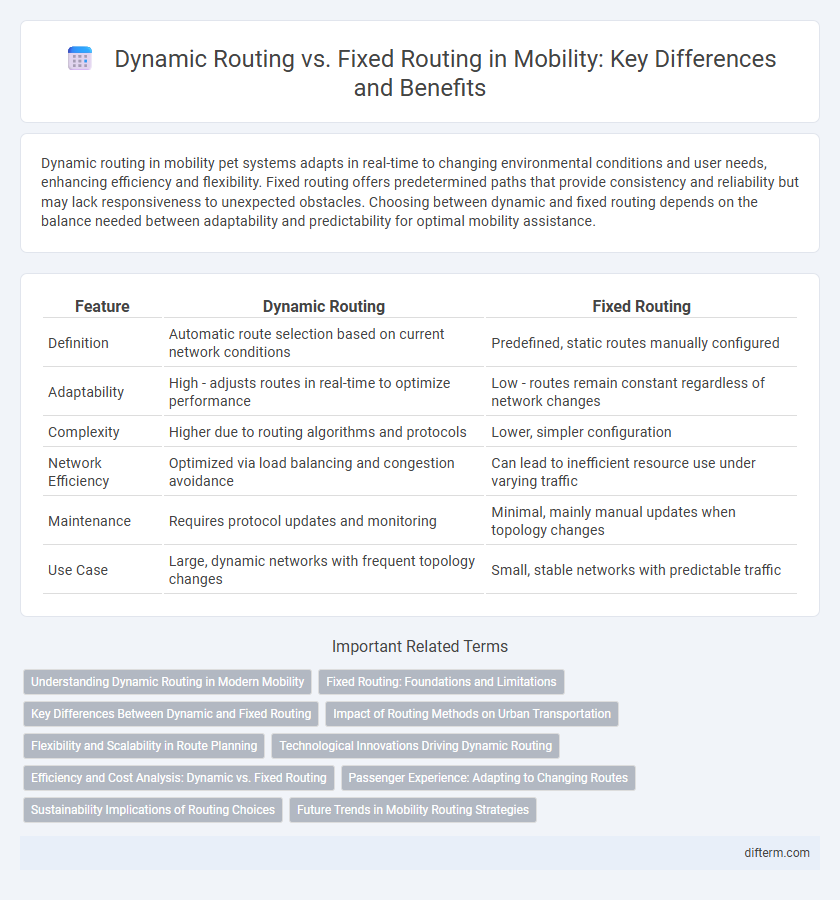Dynamic routing in mobility pet systems adapts in real-time to changing environmental conditions and user needs, enhancing efficiency and flexibility. Fixed routing offers predetermined paths that provide consistency and reliability but may lack responsiveness to unexpected obstacles. Choosing between dynamic and fixed routing depends on the balance needed between adaptability and predictability for optimal mobility assistance.
Table of Comparison
| Feature | Dynamic Routing | Fixed Routing |
|---|---|---|
| Definition | Automatic route selection based on current network conditions | Predefined, static routes manually configured |
| Adaptability | High - adjusts routes in real-time to optimize performance | Low - routes remain constant regardless of network changes |
| Complexity | Higher due to routing algorithms and protocols | Lower, simpler configuration |
| Network Efficiency | Optimized via load balancing and congestion avoidance | Can lead to inefficient resource use under varying traffic |
| Maintenance | Requires protocol updates and monitoring | Minimal, mainly manual updates when topology changes |
| Use Case | Large, dynamic networks with frequent topology changes | Small, stable networks with predictable traffic |
Understanding Dynamic Routing in Modern Mobility
Dynamic routing in modern mobility enhances transportation efficiency by continuously analyzing real-time traffic data and adjusting routes accordingly. Unlike fixed routing, which relies on predetermined paths, dynamic routing adapts to current conditions such as congestion, accidents, and road closures, minimizing travel time and fuel consumption. Integration of GPS technology and advanced algorithms enables dynamic routing systems to optimize fleet management and improve overall mobility performance.
Fixed Routing: Foundations and Limitations
Fixed routing establishes predetermined paths for data transmission in mobility networks, ensuring consistent and predictable communication flows. Its foundational simplicity offers stability in network management but lacks flexibility to adapt to changing traffic or network conditions. This rigidity can lead to inefficiencies, increased latency, and suboptimal resource utilization in dynamic mobile environments.
Key Differences Between Dynamic and Fixed Routing
Dynamic routing adapts in real-time to network changes by automatically calculating optimal paths using protocols like OSPF or EIGRP, enhancing flexibility and fault tolerance. Fixed routing relies on manually configured paths that remain constant, offering simplicity but lacking responsiveness to network failures or traffic variations. The key differences include dynamic routing's scalability and automatic route updates versus fixed routing's stability and ease of implementation in smaller or static networks.
Impact of Routing Methods on Urban Transportation
Dynamic routing adapts to real-time traffic conditions, reducing congestion and improving travel time efficiency in urban transportation networks. Fixed routing relies on predetermined paths, often leading to inefficiencies when unexpected delays or incidents occur. Integrating dynamic routing methods enhances overall mobility by optimizing route selection based on current traffic patterns and demand fluctuations.
Flexibility and Scalability in Route Planning
Dynamic routing offers superior flexibility by adapting routes in real-time based on traffic conditions, demand, and other variables, enhancing efficiency and reducing travel time. Unlike fixed routing, it scales easily with changes in fleet size or geographic coverage, supporting rapid adjustments to service expansions or disruptions. This adaptability makes dynamic routing essential for modern mobility systems that require responsive and scalable route planning solutions.
Technological Innovations Driving Dynamic Routing
Technological innovations such as real-time traffic data integration, advanced GPS algorithms, and machine learning models enhance dynamic routing by continuously adapting to changing conditions, reducing travel time and fuel consumption. These technologies enable vehicles and transportation systems to optimize routes dynamically, improving overall mobility efficiency and reducing congestion. The implementation of IoT sensors and 5G connectivity further accelerates data processing, enabling instant route recalculations for smarter navigation.
Efficiency and Cost Analysis: Dynamic vs. Fixed Routing
Dynamic routing optimizes route efficiency by continuously adjusting paths based on real-time traffic data, resulting in reduced travel time and fuel consumption compared to fixed routing. Fixed routing, while simpler to implement, often leads to increased operational costs due to inflexibility in responding to traffic fluctuations and unexpected delays. Cost analysis reveals that dynamic routing systems, despite higher initial investment in technology, deliver greater long-term savings through improved resource allocation and reduced maintenance expenses.
Passenger Experience: Adapting to Changing Routes
Dynamic routing enhances passenger experience by continuously adjusting routes based on real-time traffic conditions and demands, reducing wait times and travel delays. Fixed routing limits flexibility, often causing inconvenience during unexpected disruptions or changes in passenger flow. By leveraging data-driven algorithms, dynamic routing ensures a responsive and efficient mobility system that aligns with passenger needs and improves overall satisfaction.
Sustainability Implications of Routing Choices
Dynamic routing enhances sustainability by optimizing travel routes in real-time, reducing fuel consumption and lowering greenhouse gas emissions compared to fixed routing systems. Fixed routing often leads to inefficient paths and increased idle times, contributing to higher air pollution and energy waste. Implementing dynamic routing technologies supports eco-friendly mobility strategies essential for smart urban transportation and carbon footprint reduction.
Future Trends in Mobility Routing Strategies
Dynamic routing leverages real-time data and AI algorithms to optimize traffic flow and reduce congestion, outperforming traditional fixed routing systems that rely on static pathways. Future trends emphasize integrating 5G connectivity and edge computing to enable faster decision-making and adaptive responses to changing mobility patterns. Enhanced machine learning models will further personalize routing strategies, improving efficiency and sustainability in urban transportation networks.
dynamic routing vs fixed routing Infographic

 difterm.com
difterm.com